Plextor M3 Pro (256GB) Review
by Kristian Vättö on July 1, 2012 1:45 PM ESTRandom Read/Write Speed
The four corners of SSD performance are as follows: random read, random write, sequential read and sequential write speed. Random accesses are generally small in size, while sequential accesses tend to be larger and thus we have the four Iometer tests we use in all of our reviews. Our first test writes 4KB in a completely random pattern over an 8GB space of the drive to simulate the sort of random access that you'd see on an OS drive (even this is more stressful than a normal desktop user would see).
We perform three concurrent IOs and run the test for 3 minutes. The results reported are in average MB/s over the entire time. We use both standard pseudo randomly generated data for each write as well as fully random data to show you both the maximum and minimum performance offered by SandForce based drives in these tests. The average performance of SF drives will likely be somewhere in between the two values for each drive you see in the graphs. For an understanding of why this matters, read our original SandForce article.
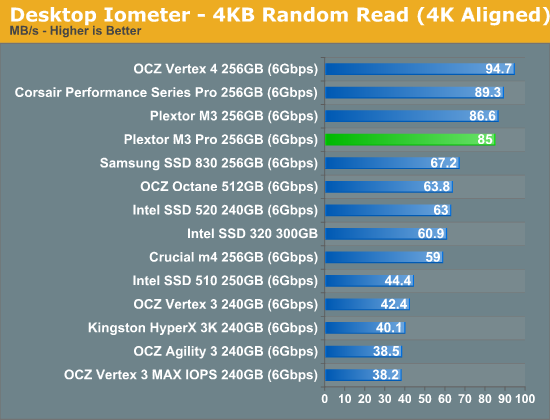
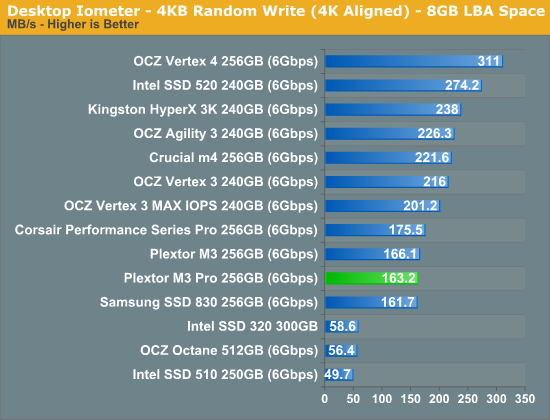
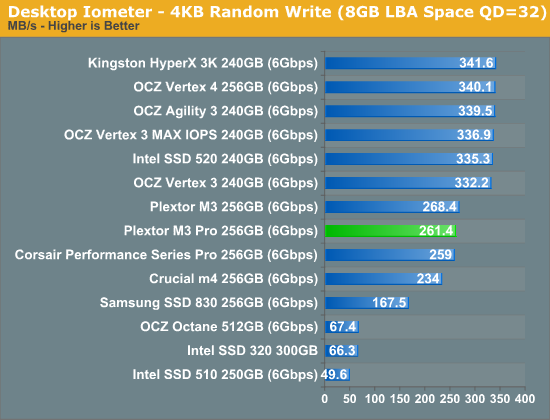
Random performance has not changed and the M3 Pro performs equally with the M3. The M3 Pro is actually slightly slower but the difference is only 1-3%, which is so small that it's within the margin of error.
Sequential Read/Write Speed
To measure sequential performance we ran a one minute long 128KB sequential test over the entire span of the drive at a queue depth of 1. The results reported are in average MB/s over the entire test length.
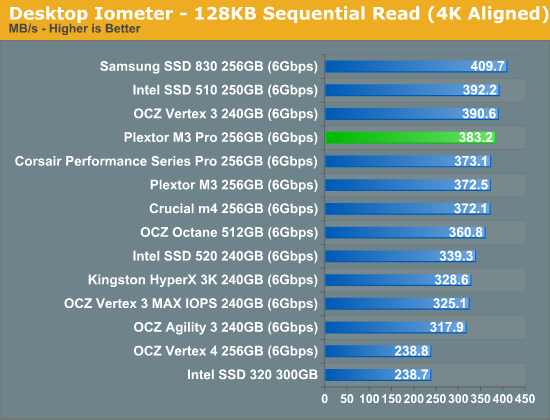
When moving to sequential read, the M3 Pro comes out as a faster drive compared to the M3. The difference is a mere 10.7MB/s, which translates to ~3%, so we aren't looking at a massive improvement here.
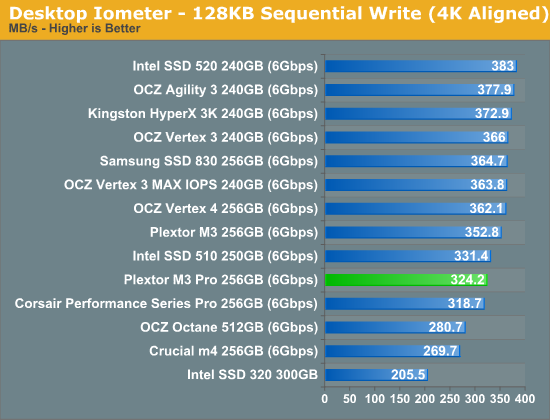
Sequential write speed turns out to be a surprise: the M3 is nearly 30MB/s (~9%) faster here. I even ran the sequential write test on the M3 Pro several times to make sure this is not an error on our end. However, it should be kept in mind that sequential write is just one aspect of performance—this doesn't mean that the M3 Pro is worse than the M3.










55 Comments
View All Comments
fausto412 - Sunday, July 1, 2012 - link
I am almost settled on Samsung 830 but even the capacity becomes an issue.256gb is what I want but that price is more than I want to pay.
Can someone explain how TRIM works?
My windows drive is fine with Battlefield 3 and Bad Company 2 installed...it is the media files that need relocation. I have read I can change the my pictures and my videos system folder locations.
jwilliams4200 - Sunday, July 1, 2012 - link
Can someone explain how to use google to find the answers to basic questions?Belard - Monday, July 2, 2012 - link
go to your browser, type in G O O G L E . C O M (each letter is a key) and press enter key.Faustso: buy a smaller drive for your OS and work Apps (MS Office) and use a HD for your games and videos and porn. Also use the HD to store an image of the SSD in case of failure.
iwod - Sunday, July 1, 2012 - link
Looks like we need 12Gbps ASAP. The Firmware design are starting to bring in less improvement %. And Idle / Active Power consumption needs to stay low as well.Belard - Monday, July 2, 2012 - link
PCI-e Drives are for that. But its stupid that none or most are non-bootable.mayankleoboy1 - Monday, July 2, 2012 - link
can you do a re-review of vertex4 120GB with the newly released 1.4 firmware?macuser2134 - Monday, July 2, 2012 - link
+1. You absolutely need to do this ASAP. Vertex 4 with the latest firmware update needs to be re-tested and updated in the AnandTech storage bench.iceman98343 - Monday, July 2, 2012 - link
you are late. vertex 4 1.5beta was released on Friday.casteve - Monday, July 2, 2012 - link
"I find it to be more hassle to put the drive inside an enclosure than to simply secure erase the drive with other methods."Buy an eSATA bracket with power for $10 from your favorite e-tailer.
NCM - Monday, July 2, 2012 - link
Based on the previous favourable review of the Plextor I bought and installed a 256GB M3 (plain) as the boot/app drive in a new Mac Pro workstation a couple of months ago, with TRIM turned on for this non-Apple drive via the Trim Enabler freeware utility. Most files are stored on our server, so capacity isn't really an issue. However I've found that our 128GB drives stand to run somewhat full, so 256GB gives plenty of storage headroom.It's been running very satisfactorily, with the responsiveness you'd expect of an SSD machine.
Just last week I bit the bullet and bought a 512GB M3 Pro for my own 13" MacBook Pro. The slight extra cost of the M3 Pro isn't meaningful in an almost $700 drive, so I saw no reason not to get the better version. I preferred the Marvell controller over Sandforce due to the incompressible data performance, and chose Plextor over a Samsung 830 due to lower power consumption in the laptop application.
My original 500GB conventional drive contains over 300GB, and while it might have been possible to prune that enough to squeeze into a 256GB, the SSD would then have run very full, affecting SSD garbage collection/TRIM. It's also necessary to leave enough free space for the hibernation RAM image, as well as for VM pages. So the 512GB version it was.
The process is straightforward. I used Apple's Disk Utility to clone the existing drive to the Plextor mounted in a Newer Tech external FW800 dock, test booted, then installed it in the MBP. TRIM is enable as above.
Performance improvement is as you'd hope, particularly since the original drive was only 5400 rpm. Another upside is the shock resistance of an SSD for mobile applications.
The only real downside is the hole-in-the-wallet effect!